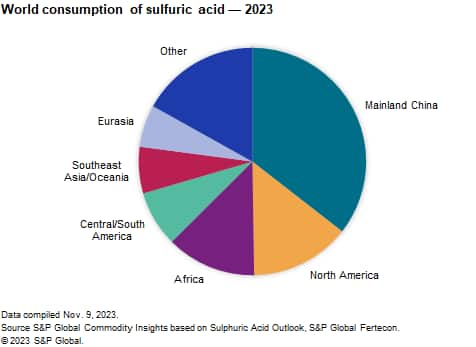Published December 2023
Sulfuric acid is one of the largest-volume industrial chemicals produced in the world. The production of fertilizers, especially phosphate fertilizers from wet-process phosphoric acid, is the major end-use market for sulfuric acid, accounting for about 60% of total world consumption in 2023. This share is expected to slightly decrease through 2028, mainly because metal leaching and steel pickling applications are expected to grow at a higher rate. About 14% of global sulfuric acid is consumed for about 20 chemical processes. Major growth drivers on a global level in decreasing order are use for metal leaching, phosphoric acid, and ammonium sulfate.
The following pie chart shows world consumption of sulfuric acid in 2023:

The majority of sulfuric acid is generated by burning sulfur; smelter acid is involuntarily produced and its economics are driven primarily by metal markets. Increased recovery of by-product sulfuric acid at smelters has had a significant impact on the industry, leading to increased trade in sulfuric acid (because by-product producers are not necessarily located near acid markets) and forcing some sulfur-burning plants to close. About 7% of world production enters the trade markets.
One portion of the sulfuric acid business that has grown as a result of environmental restrictions is the portion that regenerates sulfuric acid. Stricter environmental regulations along with satisfying customer demands and achieving operational efficiency are resulting in increased spending on plant upgrades among sulfuric acid producers.
Global demand for sulfuric acid is projected to increase during the next five years. Mainland China is the major market, accounting for more than 36% of consumption in 2023, followed by North America with about 15%. Africa, Central and South America, Southeast Asia, Eurasia and the Middle East are also large users. Fertilizer and chemical demand for sulfuric acid is forecast to increase steadily during the forecast period, while demand for industrial use is expected to grow at higher rates.
For more detailed information, see the table of contents, shown below.
S&P Global’s Chemical Economics Handbook – Sulfuric Acid is the comprehensive and trusted guide for anyone seeking information on this industry. This latest report details global and regional information, including

Key Benefits
S&P Global’s Chemical Economics Handbook – Sulfuric Acid has been compiled using primary interviews with key suppliers, organizations and leading representatives from the industry in combination with S&P Global’s unparalleled access to upstream and downstream market intelligence, expert insights into industry dynamics, trade and economics.
This report can help you:
- Identify trends and driving forces influencing chemical markets
- Forecast and plan for future demand
- Understand the impact of competing materials
- Identify and evaluate potential customers and competitors
- Evaluate producers
- Track changing prices and trade movements
- Analyze the impact of feedstocks, regulations, and other factors on chemical profitability


















